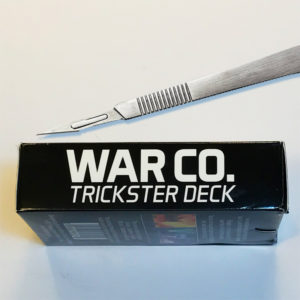Few words carry the emotional weight that “autopsy” does. It’s a morbid term associated with an analysis of what we’re all afraid of deep down. In a business context, autopsies don’t help us diagnose death, but rather failure. It is a way of helping us learn from our mistakes and adjust our behavior accordingly. A business autopsy is when you use evidence to determine why and how a project failed.

Looking for more resources to help you on your board game design journey?
Here you go: no email required!
Like this writing style?
Check out my latest blog on marketing here.
Performing a board game autopsy is scary because it requires you to look long and hard at your failures. That fear is why I saved this Start to Finish article for the spookiest time of the year. My first board game autopsy was one I did of my first game, War Co., that I wrote in April of this year. This was a little over two months after I successfully fulfilled the campaign on-time and under budget.
You’ll note that while War Co. was successful in some respects, I wrote an autopsy nonetheless to identify weak areas. You can have a successful project and still perform a project autopsy. You can even perform autopsies on projects in anticipation of failure as a way of identifying weaknesses before they are a problem. Below are some excerpts from the autopsy.
Excerpts from War Co. Autopsy
War Co. is dead. It is survived by its creator and the hundred-or-so people who believed in it enough to put money into the Kickstarter campaign.
I started the writing with humor. It made me feel better about the fact that I was about to eviscerate a childhood dream.
Things I Did Wrong with the Campaign
- THE ELEPHANT IN THE ROOM: Still not enough honest board gamer interactions.
- ANOTHER ELEPHANT: International shipping costs were way too high.
- Graphics, video, and photography were all weak.
- Stretch goal structure was really poorly done and failed to sustain momentum.
- Product still looked dodgy before the redesign in the second week.
Other Excerpts
This is a partial list of some of the things that I believe I did wrong in the campaign. Other headers started with “Things I Did Wrong with…”:
- The Product
- Fulfillment
- Sales
- Social Media
- Financially
- With Customers & The Market
- Emotionally
Moving Forward: Talk to gamers more (or at least read). Charge less for shipping. Make a better looking page. Make a better product.
This is my prescription for improving in the future. Under each header, I listed things I did wrong, and under each list, I provided suggestions for moving forward like what you see above. Providing suggestions for moving forward prevents the autopsy from being a document about kicking yourself, rather turning it into a tool to identify issues and their solutions instead. In a way, you’re putting Do Not Enter signs along paths you’ve traveled that do not work so you don’t make the same mistakes twice.

At this point, I’d like to provide a guide on how to perform an autopsy on your board game project. Each autopsy write-up you do will be highly personal and distinctive, but these five steps will give you a rough guideline.
Step 1: Start with a blunt, uncompromising statement of the facts (or your imagined worse-case scenario).
The magic of doing a project autopsy is that it provides an unflinching negative viewpoint of your project. So many creators get either excited or defensive, where both emotional states are divorced from the raw facts. State how long you’ve been working on your game, how much you’ve gotten done, how many people are paying attention, and how much money you’ve made. Tell how much you or your team have enjoyed or hated the process. Talk about what you see happening from here. Be honest as you’re doing all of this.
Step 2: Create several sections, one for each of the areas you got wrong.
The sections you choose to use in your analysis are up to you. You can use as many or as few as you like. Sectioning off your autopsy provides you with the ability to easily give it structure and prompt you to acknowledge mistakes you may have forgotten about. To get you started, here are some section suggestions.
- Game Design
- Game Production, General
- Prototypes
- Manufacturing
- General Marketing
- Target Market
- Outreach
- Kickstarter: Campaign (if you do a Kickstarter)
- Kickstarter: Fulfillment (if you do a Kickstarter)
- Sales
- Emotions
- Money
- Legal
Step 3: List all the things you or your team did wrong under each section.
This is pretty self-explanatory, though it’s arguably the hardest part. For each of the sections on the autopsy, list as many things as you can think of that you did wrong. Don’t worry about repeating yourself or meeting some kind of minimum. Don’t ignore problems because you have too many written or create ones because you don’t have enough. The point of a project autopsy is the raw honesty of it.
Step 4: List suggestions for preventing similar mistakes in the future.
Under each section, provide a list of general principles to follow going forward that will prevent you from making the same mistakes. For example, when talking about failures of War Co. as an overall product, I wrote “better play-testing, better market testing, more rigor in product manufacturing and design, don’t do multi-SKU products.” By that I mean that different play-testing and market testing methods would have helped me find more people who would have liked it sooner. More rigor in product manufacturing in design is referring to some things I’m not a fan of with the packaging, mostly minor gripes. That bit about the “multi-SKU products” refers to the fact that War Co. is a six box product, which made it tricky to deal with as a first-time game publisher. My customers never saw evidence of those struggles, but that’s because there was some hardcore organization behind the scenes.
Step 5: Periodically look back of your autopsy and compare it to your current project.
Lastly, your project autopsy should be periodically looked at. You’ll get the most benefit out of doing it initially, but every once in a while, you’ll want to compare your current project to your old autopsy. It’s so easy to slip back into old habits and make the same mistakes twice. Many times, that’s what destroys a promising creator’s career – making the same mistakes too many times before eventually falling into stagnation.





2 thoughts on “Performing a Board Game Autopsy: Learning from Your Mistakes”
Great idea Brandon! I do something similar on a monthly basis (a retrospective – it’s a term from agile software development), but I should really do it on a per game basis too. Coming back to it periodically to check you’re not making the same mistakes is very important.